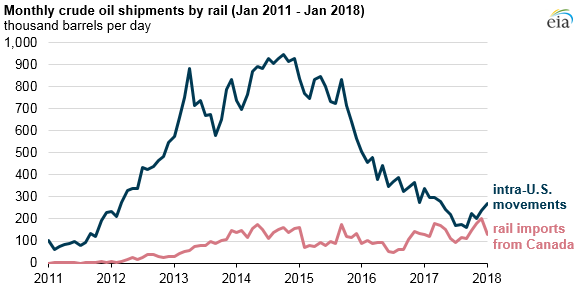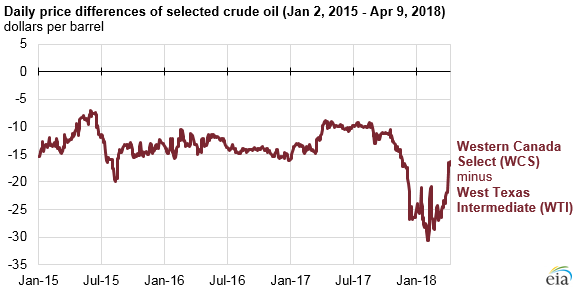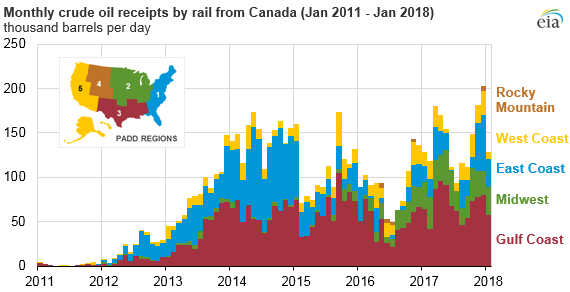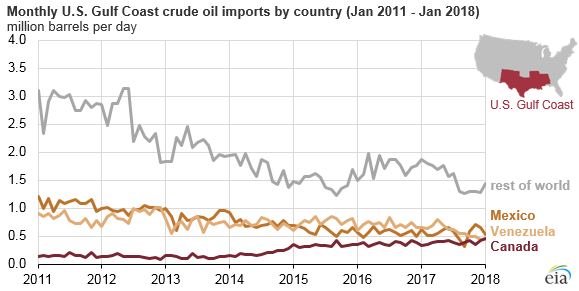
Growth in Canadian crude oil production has outpaced expansions in pipeline takeaway capacity and, along with past pipeline outages, has driven Canadian crude oil prices lower and increased Canadian crude oil exports by rail to the United States. However, the outlook for increased volumes of Canadian crude oil shipped by rail to the United States is highly uncertain despite significant U.S. demand for Canadian crude oil, specifically on the U.S. Gulf Coast.
Crude oil production in Canada increased to 3.9 million barrels per day (b/d) in 2017, up approximately 300,000 b/d from 2016. However, crude oil pipeline capacity out of Canada has failed to keep pace with growing production. Consequently, volumes of Canadian crude oil exported to the United States by rail increased in 2017. In December 2017, U.S. imports of Canadian crude oil by rail set a monthly record of 205,000 b/d, nearly matching the amount of crude oil shipped by rail within the United States that month (246,000 b/d).
Changes in the relative prices of two crude oils—Western Canada Select (WCS) in Hardisty, Alberta, and West Texas Intermediate (WTI) in Cushing, Oklahoma—demonstrate the effects of transportation constraints. Until late 2017, WCS prices averaged $10 to $15 per barrel (b) lower than WTI, largely reflecting differences in the quality of the two crudes. In late 2017 and early 2018, as crude oil production began to exceed pipeline capacity and demand to transport crude oil by rail increased, WCS priced about $25/b lower than WTI.
The price spread between WCS and WTI has since narrowed to an average of $16/b in early April, suggesting some demand for transporting Canadian crude oil by rail has lessened. Low WCS prices may have led some Canadian crude oil producers to reduce output and advance schedules for planned maintenance, likely reducing the need to move crude oil by rail.

Of the 144,000 b/d of Canadian crude oil imported by rail in 2017, about half (70,000 b/d) went to the U.S. Gulf Coast, or Petroleum Administration for Defense District (PADD) 3. Imports by rail made up 18% of total Canadian crude oil imports to the Gulf Coast, and 2% of the 3.1 million b/d of total crude oil imported by the Gulf Coast in 2017.

With an API gravity of approximately 20 degrees, WCS crude oil is a heavy crude oil that is attractive to Gulf Coast refiners that process heavier crude oil. Traditional suppliers of heavy crude oil into the Gulf Coast region, such as Venezuela and Mexico, have experienced production declines that resulted in lower crude oil exports, making Canada an increasingly important source of U.S. imports of heavy crude oil.

In January 2018, the U.S. Gulf Coast imported more crude oil from Canada (448,000 b/d) than from Venezuela (438,000 b/d) for the first time on record and imported more crude oil from Canada (379,000 b/d) than from Mexico (309,000 b/d) in September 2017. Another outlet for Canadian crude oil on the Gulf Coast may be re-exports. Since the removal of restrictions on crude oil exports from the United States, Canadian crude oil can be re-exported from the Gulf Coast without having to be segregated.
Large-scale and sustained increases in crude oil by rail volumes from Canada face several obstacles from the Canadian rail industry and competing pipeline projects. Trade press reports indicate that before investing, Canadian rail companies are requiring that crude oil producers enter long-term commitments for crude oil-by-rail capacity. Canadian crude oil producers have been reluctant to agree to long-term rail commitments because pipeline capacity could increase in the short to medium term as new pipeline projects come online and some currently operating pipelines begin to ease volume restrictions.
Principal contributors: Arup Mallik, Mason Hamilton

Follow us on social media: